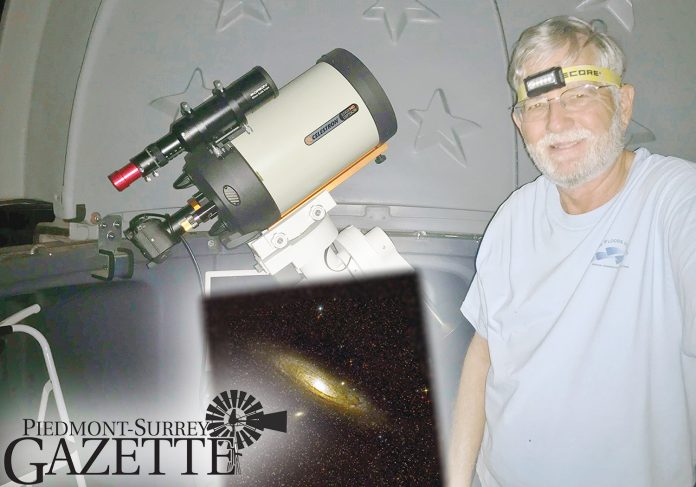
By Carol Mowdy Bond
Contributing Writer
There’s a surprise tucked into a Surrey Hills backyard. That’s because Dr. Rich Chambers has his observatory sitting just a bit off of his back patio. A retired geologist, Chambers has taken up astrophotography. He’s bringing the universe down to Earth for all to see, and he is posting his photos on Facebook.
“I’ve been doing photography since the 1970s,” Chambers said. “But I really got started into astrophotography about 6 years ago because of my brother. And I went into deep space about 2 years ago, buying the equipment I needed. Now I have a home observatory in my backyard, and it’s on the golf course so I have a lot of open sky.”
With a low light camera, Chambers is quick to say that he’s ordered an astronomy camera.
“My telescope is on a mount that compensates for the Earth’s rotation,” said Chambers. “I line it up with the North Star and do several star alignments, and then I have an app on my iPad and can shoot photos. I have 60 seconds to a couple of minute exposure.”
For each photo Chambers creates, he builds the image off of many photos.
“I take 40 to 100 images, and use special software to get the image that we see,” Chambers said. “Some images are 14,000 light years away from the earth. Some are 28 to 30 million light years away from earth.
“The definition of a light year is that light travels 6 trillion miles in 1 year. The farthest galaxy seen is 130 million light years out. I captured it with another galaxy I was shooting.”

Chambers said the most exciting image he’s photographed is probably the Eagle Nebula also known as The Pillars of Creation. “Those are about 14 to 15,000 light years out, but in our own galaxy,” Chambers said. “All the stars we can see right now in the sky are in our own galaxy, the Milky Way. They’re not in other galaxies. The stars we see are not in real time. Nothing in the sky we see is in real time, not even sunlight.”
“The next exciting thing coming is the launch of the James Webb Space Telescope,”
Chambers said. “It will launch in the next couple of years. It will show the point of creation of the universe.”
NASA is planning that the James Webb Space Telescope will succeed the Hubble Space Telescope as the next flagship astrophysics mission.
“The Hubble looks back about 12 billion years in time,” Chambers said. “The James Webb will have an infrared telescope. So, it will look at the universe in infrared, which will be a totally different view.”
Born in Iowa, Chambers grew up in southern California starting in about third grade. He earned his bachelor’s and master’s degrees in geology from the University of Montana. He went on to Michigan State University in East Lansing, earning his doctorate in geology.
A geologist for 42 years, Chambers spent 8 years as a government and environmental scientist on the Great Lakes, at the National Oceanic and Atmospheric Administration (NOAA) Great Lakes Environmental Research Laboratory in Ann Arbor, Michigan. Then he took his career into the private sector.
Chambers shot a picture of the bulk carrier SS Edmund Fitzgerald just a few days prior to when it sank on November 10, 1975.
“It was there and I shot a picture,” Chambers said. “Then it was gone.” Due to a storm, the ship sank in Lake Superior near Whitefish Point, Michigan. The entire crew was lost.
Canadian singer-songwriter and guitarist Gordon Lightfoot memorialized the event with his folk song “The Wreck of the Edmund Fitzgerald,” released in 1976.
Every couple of years, Chambers and his wife make a trip back to Montana, where he gets back into his love of geology. “We planned a trip for this past summer, but COVID-19 hit,” said Chambers.
Connect with Chambers and see his photos on Facebook at Rich Chambers.





